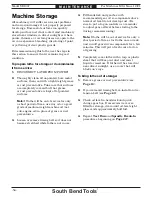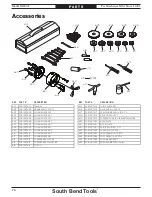
South Bend Tools
For Machines Mfd. Since 12/21
Model SB1007
-63-
TROUBLESHOOTING
Symptom
Possible Cause
Possible Solution
Bad surface finish.
1. Wrong spindle speed or feed rate.
1. Adjust for appropriate spindle speed and feed rate.
2. Dull tooling or poor tool selection.
2. Sharpen tooling or select a better tool for intended
operation.
3. Tool height not at centerline.
3. Adjust tool height to centerline (see Page 39).
4. Too much play in gibs.
4. Tighten gibs (see Page 58).
Tapered tool
difficult to remove
from tailstock quill.
1. Quill is not retracted all the way
back into tailstock.
1. Turn quill handwheel until it forces tapered tool out
of quill.
2. Contaminants not removed from
taper before inserting into quill.
2. Clean taper and bore and re-install tapered tool.
Cross slide,
compound, or
carriage feed has
sloppy operation.
1. Gibs are out of adjustment.
1. Adjust gib screw(s) (see Page 58).
2. Handwheel is loose or has excessive
backlash.
2. Tighten handwheel fasteners; adjust handwheel
backlash to a minimum (see Page 57).
Cross slide,
compound, or
carriage feed
handwheel is hard
to move.
1. Ways loaded with chips, dust, or
grime.
1. Clean ways and lubricate.
2. Gib screws are too tight.
2. Loosen gib screw(s) slightly, and lubricate bedways
(see Page 58).
3. Backlash setting too tight (cross
slide, compound rest only).
3. Slightly loosen backlash setting (see Page 57).
4. Bedways are dry.
4. Lubricate bedways and handles.
Cutting tool or
lathe components
vibrate excessively
during cutting.
1. Tool holder not tight enough.
1. Check for debris, clean, and retighten.
2. Cutting tool sticks too far out of tool
holder; lack of support.
2. Re-install cutting tool so no more than
1
⁄
3
of the total
length extends from tool holder.
3. Cutting tool dull.
3. Replace or resharpen cutting tool.
4. Incorrect spindle speed or feed rate.
4. Use recommended spindle speed.
5. Gibs are out of adjustment.
5. Adjust gib screws at affected component (see Page
58).
Machine has
vibration or noisy
operation.
1. Workpiece or chuck at fault.
1. Center workpiece in chuck or faceplate; replace
defective chuck.
2. Chuck or cutter at fault.
2. Replace unbalanced chuck; replace/sharpen cutter;
use correct feed rate.
3. Machine incorrectly mounted on
stand.
3. Adjust feet, shim, or tighten mounting hardware.
4. Bit chattering.
4. Replace/sharpen bit; index bit to workpiece; use
correct feed rate and cutting RPM; retract tool
holder and position workpiece closer.
5. Pulley loose or mis-aligned.
5. Re-align/replace pulley and firmly secure in place.
6. Timing belt worn or loose.
6. Inspect/replace with new belt.
7. Motor fan rubbing on fan cover.
7. Fix/replace fan cover; replace loose/damaged fan.
8. Motor mount loose or broken.
8. Tighten/replace.
9
.
Motor bearings at fault.
9. Test by rotating shaft; rotational grinding/loose
shaft requires bearing replacement.
10. Motor or component loose.
10. Inspect/replace damaged bolts/nuts, and retighten
with thread-locking fluid.
















































